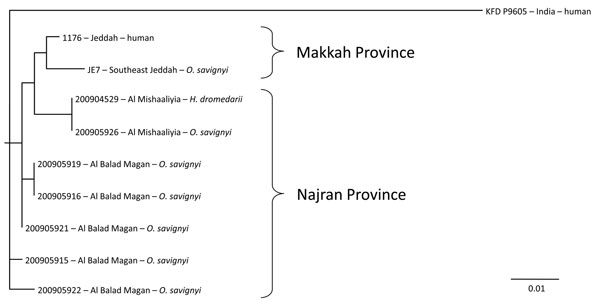Volume 17, Number 5—May 2011
Letter
Kyasanur Forest Disease Virus Alkhurma Subtype in Ticks, Najran Province, Saudi Arabia
Figure

Figure. Phylogenetic analysis of Alkhurma viruses isolated from Ornithodoros savignyi and Hyalomma dromedarii ticks in Najran Province, Kingdom of Saudi Arabia. A 390-bp region of the core protein C and preM genes was amplified and sequenced for each of the isolates (HQ443410–6) by using primers ALK244S (5′-GTGTTGATGCGCATGATGGG-3′) and ALK665R (5′-TGCAGAAACAGTCCACATCA-3′). A maximum-likelihood analysis was conducted with available sequences in GenBank for ALK (NC_004355; 3) by using Kyasanur Forest disease (AY323490) as the outgroup and the default settings in GARLI version 0.96b8 (www.phylo.org/pdf_docs/zwicklDissertation.pdf). Scale bar indicates substitutions per site.
Page created: August 14, 2011
Page updated: August 14, 2011
Page reviewed: August 14, 2011
The conclusions, findings, and opinions expressed by authors contributing to this journal do not necessarily reflect the official position of the U.S. Department of Health and Human Services, the Public Health Service, the Centers for Disease Control and Prevention, or the authors' affiliated institutions. Use of trade names is for identification only and does not imply endorsement by any of the groups named above.